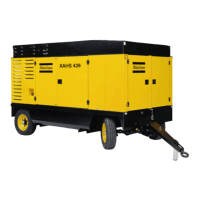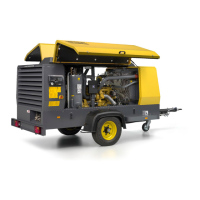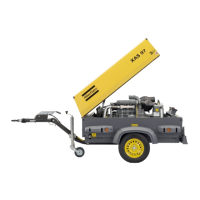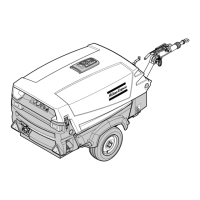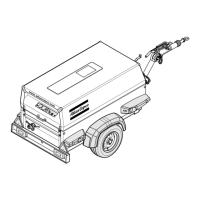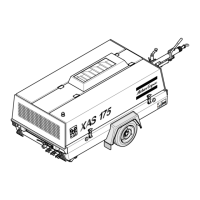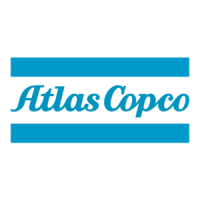
Do you have a question about the Atlas Copco XAMS 1150 CD7 T3 APP and is the answer not in the manual?
| Model | XAMS 1150 CD7 T3 APP |
|---|---|
| Working Pressure | 7 bar |
| Type | Rotary Screw Compressor |
| Operating Pressure | 100 psi (7 bar) |
| Engine | Diesel |
| Free Air Delivery | 1150 cfm (32.6 m³/min) |
General safety advice and policy overview for using Atlas Copco equipment.
Essential safety rules for operating and maintaining machinery, covering cleanliness and device functionality.
Procedures and precautions for safely moving and setting up the compressor unit.
Guidelines for safe operation, including handling gases, hoses, and environmental factors.
Rules and precautions for performing maintenance and repair work safely on the equipment.
Guidelines for using tools correctly to prevent accidents and damage.
Detailed safety measures for specific components like batteries, pressure vessels, and safety valves.
Overview of compressor models, their specifications, engine, and core systems.
Details on the engine, compressor unit, oil system, and regulation mechanisms.
Description of cooling, safety devices, frame, bodywork, lifting, control panel, and data plate.
Explanation of built-in safety features like thermal shutdown sensors and safety valves.
Information on the structural support and mobility components of the unit.
Details on the unit's enclosure, maintenance access, and the control panel layout.
Information regarding unit identification and specifications found on the data plate.
Visual representation of air intake, compression, and delivery through the system.
Schematic showing the circulation and management of oil within the compressor system.
Index of electrical components and their locations within the circuit diagrams.
Procedures for safely parking, towing, and lifting the compressor unit.
Guidelines for safely lifting the compressor, including capacity and sling angle.
Details on the timed internal lighting system and its settings.
Information on the optional preheater, its function, and operation.
General explanation of unit statuses and operations.
Pre-operation checks and procedures before starting the compressor.
Step-by-step guide for starting and stopping the compressor.
Explanation of the control panel buttons and their functions for unit operation.
Summary of operational states, checks, and battery switch usage.
Instructions and warnings regarding the use of the battery switch.
Detailed steps for starting the compressor after initial setup or fuel filter change.
Guide to understanding the various icons displayed on the control panel.
Explanation of different display views and navigation methods on the control panel.
Detailed steps and displays for initiating the compressor start sequence.
Procedure for safely stopping the compressor and its associated displays.
Explanation of critical alarm or emergency stop shutdown displays.
Instructions for safely switching off the compressor controller and battery.
Options for adjusting system parameters, language, units, and features.
Instructions for operating the compressor using a remote control.
Disclaimer regarding damage from non-original parts or unauthorized modifications.
Information on service packs and kits for specific maintenance tasks.
Recommendations for storing the compressor when not in use.
Crucial safety rules to follow before and during maintenance operations.
Summary of recommended maintenance intervals based on operating hours.
Detailed schedule for compressor maintenance tasks.
Specifications and order numbers for PARCOOL S and PARCOOL S Xtreme compressor oils.
Specifications and order numbers for PAROIL E xtra and PAROIL E engine oils.
Procedure for checking and topping up the engine oil level.
Procedure for checking and topping up the compressor oil level.
Guidance on changing engine oil and oil filters.
Procedure for adding oil to the compressor to reach the correct level.
Specifications and benefits of PARCOOL EG coolant for engines.
Methods for checking coolant quality including visual, pH, and glycol concentration.
Procedures for adding or replacing coolant in the system.
Step-by-step instructions for draining and replacing the engine coolant.
Instructions for cleaning the compressor's coolers to maintain efficiency.
Steps to activate a new dry-charged battery.
Safety precautions and procedures for handling battery electrolyte.
Guidance on safely recharging the unit's battery.
Information on using distilled water for battery top-up.
Procedure for adjusting the continuous pneumatic regulating system's working pressure.
Identification of the main components of the air filter system.
Instructions for cleaning the dust trap on the air filters.
Procedure for replacing air filter elements and safety cartridges.
Instructions for priming the fuel system before operation.
Procedure for adjusting brake shoes on units without ABS.
Overview of the ABS braking system and its pneumatic settings.
Troubleshooting steps for issues with compressor output.
Diagnosing and resolving high air receiver pressure faults.
Troubleshooting reasons for unexpected unit shutdowns.
Addressing oil mist expulsion from air filters after stopping.
Steps to diagnose and resolve compressor overheating problems.
Important safety rules related to the alternator and battery connections.
Diagnosing and fixing issues with the heater not starting or stopping.
Description of the undercarriage option for site mobility.
Options for mounting and integrating larger fuel tanks.
Skid mounting and integrated fuel tank options for site access.
Recommended torque values for assembly of compressor components.
Standard operating conditions used for performance data.
Maximum and minimum operating parameters for compressor performance.
Key performance metrics including fuel consumption and air delivery.
Charts showing maximum working pressure vs. altitude and ambient temperature.
Specific design parameters for the compressor unit.
Specifications related to the engine, including bore, stroke, and output.
Technical data for the electric refuel pump.
Specifications for the remote control system's range.
Physical dimensions of the compressor unit in different configurations.
Parts subject to Pressure Equipment Directive 97/23/EC, Cat. II and above.
Atlas Copco's policy on minimizing negative environmental effects of products.
Procedures for safely disposing of contaminated substances and machine parts.

